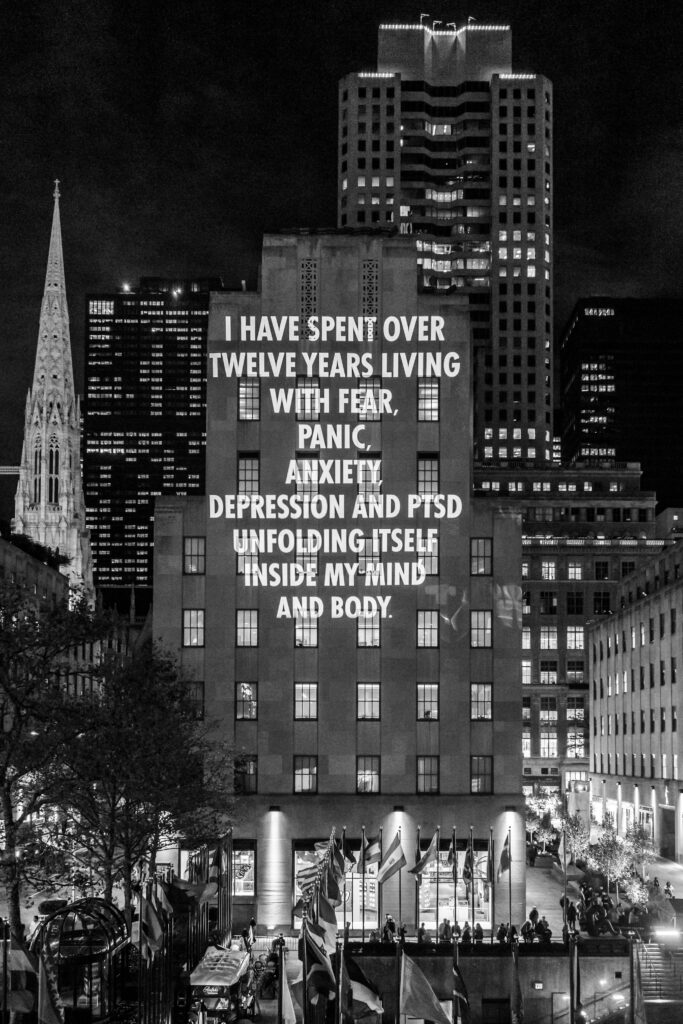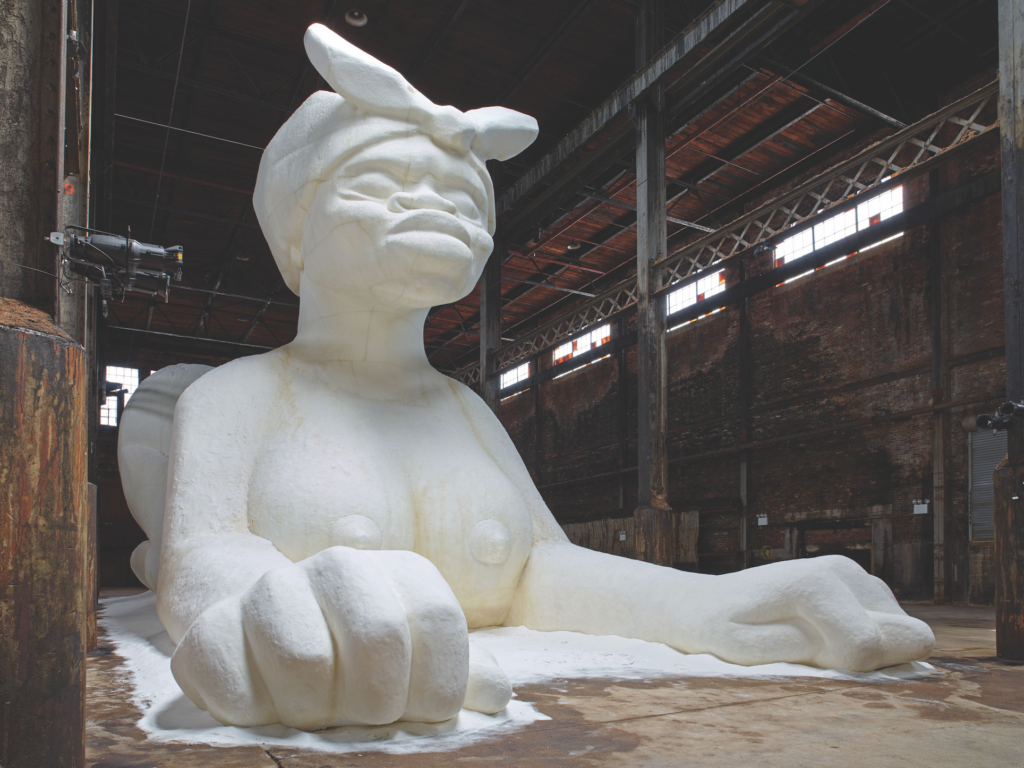
Vigil, Jenny Holzer, 2019 (image courtesy of Creative Time)
Two art powerhouses celebrate half a century of groundbreaking, game-changing exhibitions. DAVID GRAVER investigates how they got there and what’s in their futures.
The great allure of New York City’s art scene is not due to the singular reputations of museums like the Met and MoMA; the Whitney and the Guggenheim; or mega-galleries like Pace, David Zwirner, and Gagosian; but also due to the way all these institutions work together to forge a comprehensive cultural tapestry. This year, two risk-taking, community-oriented organizations integral to the artistic fabric of the city celebrate their 50th anniversaries. Though structurally different, the way Dia Art Foundation and Creative Time have embraced artists and encouraged discourse contributes to their longevity and success.
Fariha Friedrich (then known as Philippa de Menil), Heiner Friedrich, and Helen Winkler Fosdick formed Dia Art Foundation to help artists realize projects of immense scope and scale. In addition to maintaining nine permanent sites in the U.S. and Germany (including Walter De Maria’s The Lightning Field, completed in 1977 near Quemado,
New Mexico), Dia commissions single-artist projects for three exhibition locations across New York State: Dia Chelsea in New York City, Dia Beacon in the Hudson Valley, and Dia Bridgehampton on Long Island. Equally important, Dia’s sites and locations are free for the public to visit.
Creative Time was also founded to present ambitious art projects. Founders Karin Bacon, Susan Henshaw Jones, and Anita Contini envisioned bold public works throughout NYC, the U.S., and abroad. Creative Time fosters, literally, art for the masses. Universal human rights, freedom of expression, and the necessity of dialogue underpin the organization’s efforts—as evidenced by Tribute in Light, the beacons that rise from the site of the former Twin Towers each anniversary of September 11, and Kara Walker’s A Subtlety in 2014. For the latter, Walker placed a large-scale, sugar-coated, sphinxlike woman amidst the bones of Brooklyn’s legendary Domino Sugar Factory. The installation drew long lines for weeks. Recently, Creative Time has launched programs that offer foundational support for artists, ranging from the opening of their Creative Time headquarters, CTHQ, which provides weekly programs around community, to their Research and Development Fellowships for socially engaged artists. Both center on the artistic process rather than a final product.

A Subtlety, Kara Walker, 2014 (image courtesy of Creative Time)
Not only do these two organizations court change (and sometimes controversy), they also both consider it necessary. “The continued commitment to embracing risk is integral, especially in challenging times,” Creative Time’s executive director, Justine Ludwig, tells Avenue. “We think in radically different ways. We address challenging subject matter through our practice.” She references Gran Fury’s powerful 1989 project “Kissing Doesn’t Kill: Greed and Indifference Do,” a photographic campaign on postcards and buses that emulated traditional advertising but with a twist: they featured queer and interracial couples kissing. It birthed much conversation. “The arts are a rich space for making the imagined real,” Ludwig continues, weaving in their commitment to social impact, “and for creating sites of exchange. That has been rooted in our thinking from the get-go.
I think about projects like Waiting for Godot in New Orleans, which we did with Paul Chan post-Katrina, or Jeremy Dellers’ ‘It Is What It Is: Conversations About Iraq,’ where he drove across the country in 2009, having conversations with people about the war. These were seminal projects that shifted discourse.” Ludwig wasn’t at Creative Time in 2009; rather, she was in Cincinnati when Dellers passed through. She witnessed direct conversation born from his project.
“You are more open and willing to engage with challenging or unexpected subject matter in the context of art,” she adds. Ludwig observed this again while working with Charles Gaines on “The American Manifest,” in conjunction with Governors Island Arts and Times Square Arts. For this three-part installation, Gaines placed monumental sculptural and sonic works in New York and Cincinnati that addressed the Dred Scott decision of 1857, wherein the Supreme Court declared that no person of African descent, enslaved or free, was eligible to be a United States citizen. (Eleven years later this was overturned by the 14th Amendment).
“We were founded in 1974, and thinking about the cultural landscape at that moment allows us to see that we were founded in crisis. That is an important thing to remember. It is at the core of who we are and how we exist.” – Justine Ludwig, Creative Time executive director
“Working on that project changed my life. There’s something alchemical about watching a project go from a verbalized idea to a physically realized object that so beautifully and powerfully encompasses all the ideas an artist puts forth,” Ludwig says. “We had been working on the project for almost a decade at that point. It predates almost everybody on the team. There were so many starts and stops, but there was faith that the project was important and needed to exist in the world. There was so much stewardship and so much care and so much vulnerability from Charles.
“We are in this moment of unrelenting crisis,” she stresses. “If we are looking to artists and saying,‘Help us think otherwise, help us imagine a way forward,’ we have to support them in their research and their engagement with experts in diverse fields to make sure this isn’t siloed thinking. That goes far beyond the art world itself.” To sustain this mission over the next 50 years, Ludwig sees their community programs and a slate of ambitious projects as ways of connecting—and not just with a traditional audience that goes to the museum on the weekend, but those interested in other entry points for work that addresses the moment we are living in.
“We were founded in 1974, and thinking about the cultural landscape at that moment allows us to see that we were founded in crisis. That is an important thing to remember. It is at the core of who we are and how we exist,” Ludwig explains. “It’s also important to associate this with other organizations that came up in the ’70s. We are a collective of individuals who believe in and make magic happen. We have the ability to be responsive to the contours of an ever- changing world. We are built on the creativity of individuals.”
This sentiment rings true for Dia Art Foundation and their 50 influential years, as well. Jessica Morgan, the director of Dia, attributes their success to an unwavering commitment to their founding mission. Yes, they are a collecting institution with many sites, but they also seek out long-term partnerships with artists. “This isn’t about a fleeting exhibition but a lifelong commitment to their practice,” she says. “That is something that has always been a part of Dia through the ups and the downs and the highs and the lows.”

Dan Flavin (image courtesy of Dia Art Foundation)
Curatorial vision is a connective tissue between time periods and locations. “We look back to move forward,” Morgan says. “That doesn’t mean that we are looking for people who paint like Agnes Martin or people who make land art like Walter De Maria. It is looking for a certain sensibility. That tends to be found in artists who have a life mission—who are on a path and won’t deviate. We need to have a raison d’être for showing an artist. Between all of us at Dia who are involved programmatically, there are many artists who we think are absolutely outstanding, but they wouldn’t make sense here.”
Dia Art Foundation’s collection encompasses thousands of pieces, but only from 70 or so artists. “When we do make a commitment and bring an artist into the collection, it’s not about acquiring one work. It’s about how we can work with them across multiple displays and exhibitions and publications and talks. That’s a very unique approach,” Morgan says. Because of this sustainable support, artists feel a real sense of wanting to belong with Dia.
“I came in with a huge enthusiasm for the collection and seeing its potential and wanting to reinvigorate our commissioning program,” Morgan says of her beginning, now more than a decade ago. “We say that we focus on the ’60s and ’70s because that’s where we began, but when we were founded these weren’t historical artists, they were contemporary. They were figures of that moment. It’s been equally important that we’ve had a vibrant approach to commissioning now and doing the work that Dia always did—which was giving ample space, time, and resources to single artists to achieve these extraordinary projects today.”
“We quite deliberately make a choice to work with artists who are lesser known or have not shown in a substantial way in New York or even the U.S., who often have no commercial gallery and therefore no support.” – Jessica Morgan, director Dia Art Foundation
With 12 sites in the Dia ecosystem, few people will ever agree upon a favorite. Both Dia Beacon and Dia Bridgehampton warrant repeat visits for their commissions and their existing collections featuring the work of Dan Flavin, Richard Serra, Sol LeWitt, Gerhard Richter, Louise Bourgeois, and many more. With large-scale exhibitions ranging from Delcy Morelos’s multisensory El abrazo to Steve McQueen’s powerful, current eponymous show, Dia Chelsea operates at the highest level.
That said, “David Hammons once said to me that he felt The New York Earth Room was the heart of New York City,” Morgan says of the permanent Walter De Maria sculpture. “I would agree to some degree. Walter De Maria’s works and most certainly The New York Earth Room are really, quintessentially, so important to Dia. I almost think of Walter De Maria as our fourth founder.”
As with Creative Time, Dia Art Foundation aims to offer a platform to artists, most often emerging ones, striving for discourse. “In general, we quite deliberately make a choice to work with artists who are lesser known or have not shown in a substantial way in New York or even the U.S., who often have no commercial gallery and therefore no support,” Morgan says. “They are frequently working in a medium that is inherently difficult to support through a commercial practice. That is something we think about when we are working with artists: who are the ones that our support would enable, especially if their work would not happen otherwise?”
Next, Dia plans to unveil a landscaping and outdoor park project that will be accessible to everyone for free, not just Dia Beacon guests. “It will be significant not only for our community but for our visitors,” Morgan says. “It’s something I’ve wanted to work on since I arrived at Dia. Ten years on, it feels very satisfying to be in a position to undertake this. We’ve been working with the most incredible landscape architect and artist, Sara Zewde, who is up there with all the artists we’ve worked with. She’s just been an absolute inspiration to work with and came up with an incredible proposal. It will be transformational for Dia Beacon.”

Nancy Holt in Sun Tunnels, 1976 (image courtesy of Dia Art Foundation)
Much of the legacy of both organizations rests in the hands of their visionary talent, whether that’s Dia Art Foundation’s senior adjunct curator of special projects, Donna De Salvo, who was a Dia curator in the ’80s, or Creative Time’s head curator, Diya Vij. “Creative Time was one of the first organizations that transformed what I thought was possible in the art world,” Vij shares. “To me, Creative Time modeled what it looked like to be as courageous and audacious as the artists they worked with.” Vij hopes that the next 50 years of Creative Time see continued risk-taking support for artists. With such thought-provoking programming, it’s almost guaranteed. And the same can surely be said for Dia Art Foundation across its constellation of inspiring sites.

